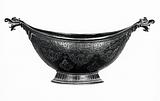Begging bowl (kashkul), cast, engraved, and tinned bronze
India, Deccan; c. 1600
H: 16.7; L: 38.5; D: 16 cm
Boat-shaped begging bowls made of coco de mer (a rare type of coconut), wood, or metal were typical accessories for many wandering dervishes, along with staffs and certain articles of clothing. This heavy and magnificent bowl, however, was probably displayed in one of the many Shiite shrines that can still be found in the Deccan.
The painstakingly executed Thuluth inscriptions that stand out smoothly against the engraved background, both inside and out, are passages from the Koran and Shiite invocations. The boat shape, which terminates in dragon heads, is Persian in origin, but the dense, engraved decoration and lovely brownish patina are typical of a group of metal objects made in the Deccan.
Inv. no. 61/1998
Published in:
Mark Zebrowski: Gold, silver and bronze from Mughal India, London 1997, fig. 567a and b, pp. 341, 345, and 352;
George Michell and Mark Zebrowski: Architecture and art of the Deccan Sultanates, Cambridge 1999, fig. 177, p. 239;
Kjeld von Folsach: Art from the World of Islam in The David Collection, Copenhagen 2001, cat. 551;
Sheila S. Blair and Jonathan M. Bloom (eds.): Cosmophilia. Islamic Art from the David Collection, Copenhagen, McMullen Museum of Art, Boston College, Boston 2006, cat. 36;
Navina Najat Haidar and Marika Sardar: Sultans of Deccan India, 1500-1700: opulence and fantasy, Metropolitan Museum of Art, New York, New Haven 2015, cat. 156;
Joachim Meyer, Rasmus Bech Olsen and Peter Wandel: Beyond words: calligraphy from the World of Islam, The David Collection, Copenhagen 2024, cat. 62, pp. 204-205;




